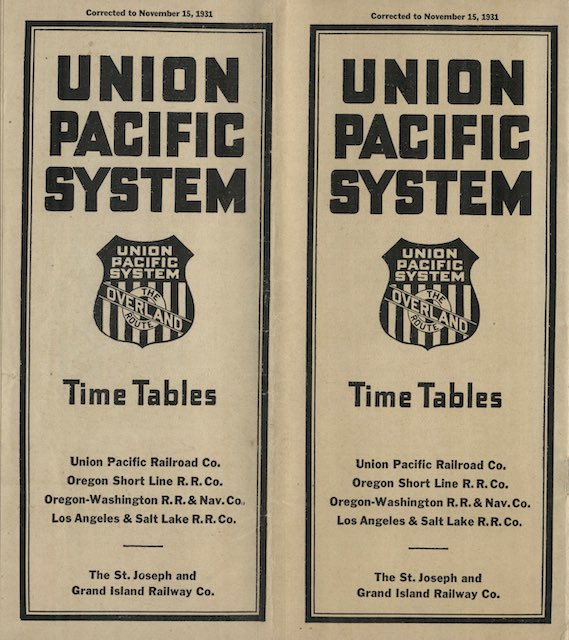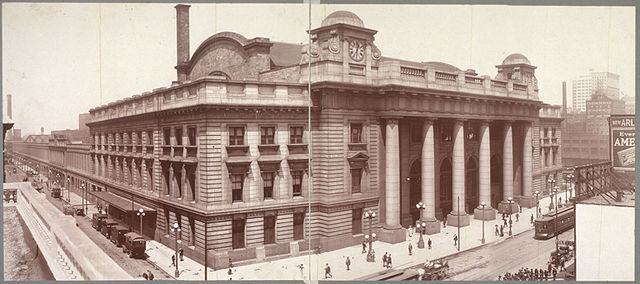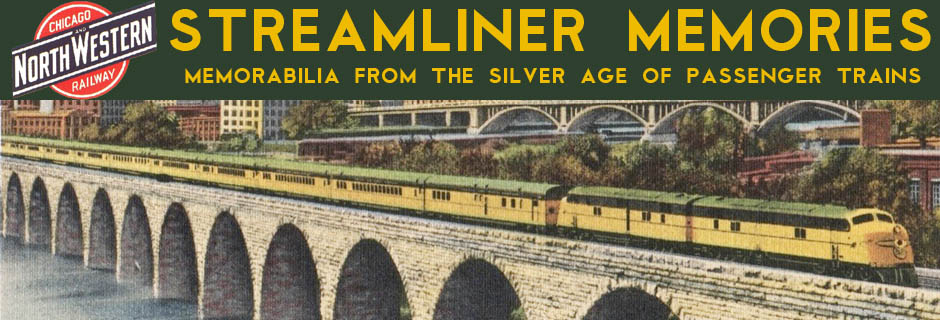This timetable from Streamliner Memories reader Tim Zukas, like yesterday’s, has two half-page ads on the front cover while the cover shown below is the back cover. One of the half-page ads is for the Los Angeles Limited, which the ad brags has “mechanical heat control” to make passengers “as warm as you want” during winter travel. Of course, by 1931 almost all passenger trains had steam heat, but this probably meant that passengers in sleeping rooms had more control over the temperatures than earlier trains.
 Click image to download a 48.4-MB PDF of this timetable.
Click image to download a 48.4-MB PDF of this timetable.
The other half-page ad is for the Gold Coast Limited‘s “new morning departure from Chicago,” as the train was scheduled to leave the Windy City at 10:30 am. In yesterday’s 1929 timetable, the train left at 2:30 pm, while other Los Angeles-bound trains left at 8:10 pm (Los Angeles Limited) and 11:20 pm (Continental Limited). For 1931, the Los Angeles Limited was pushed back to 9:30 pm while the Continental Limited was replaced by (or merged with) the Pacific Limited, departing at 11:20 pm and splitting in Ogden with a section to San Francisco and a section to Los Angeles.
Wikipedia seems to be somewhat confused about the Gold Coast Limited. It says that the train began operating on November 14, 1926 and was “temporarily discontinued” on June 14, 1931 and not revived until 1947. However, it appears it was still operating in November 1931.
According to Union Pacific’s 1929 Book of Trains, the main virtue of the Gold Coast Limited was that it allowed a quick connection at Chicago with morning trains from the east. Perhaps some changes in schedules of eastern railroads allowed more trains to arrive in Chicago early enough for passengers on those trains to transfer to the North Western station in time for a 10:30 am departure.

North Western Station in 1912. Click image for a larger view.
This makes me wonder why UP chose to partner with the North Western at all. If it had its trains go over the Rock Island between Omaha and Chicago, they could have connected with the New York Central at LaSalle Street Station. If/when they went over the Milwaukee or even Burlington (not likely because Burlington was a competitor to Denver and Portland), they would have connected with the Pennsylvania at Union Station. If its trains had gone over the Illinois Central, they could have connected with the Michigan Central and Chesapeake & Ohio (after 1925) at Central Station. Meanwhile, competitor Santa Fe went to Dearborn Terminal, where it connected with the Chesapeake & Ohio (before 1925), Erie, and Grand Trunk.
In 1969, Chesapeake & Ohio/Baltimore & Ohio rerouted their trains to North Western station, but by that time it was too late for UP trains which had transferred to the Milwaukee Road in 1956. Otherwise, the North Western was the biggest station in Chicago that didn’t connect with any eastern lines.

It’s interesting that into the 1930s (or even 40s), a major railroad like Union Pacific was still publishing timetables with nondescript, monochrome covers…especially considering their obvious importance to railroads as a marketing tool.
Competitors like the Burlington Route and Northern Pacific were at least using two colours (red and black) on their covers from the 1910s, while Southern Pacific was using red and deep blue in 1912 (although by 1927-30, they went with just a blue-saturated cover). Rio Grande & Western Pacific used black and a deep tuscan red on their Feb-Mar 1924 timetable. Canadian Pacific (albeit not a competitor) used red and black on yellow covers.
Looking ahead, it looks like it might not have been until 1946 or 47 that UP finally abandoned monochrome black ink and switched to colour timetable covers. All the more odd, since by the mid-30s, they were putting so much marketing effort into their brand new streamliners!